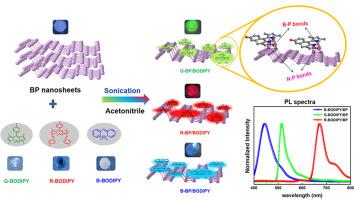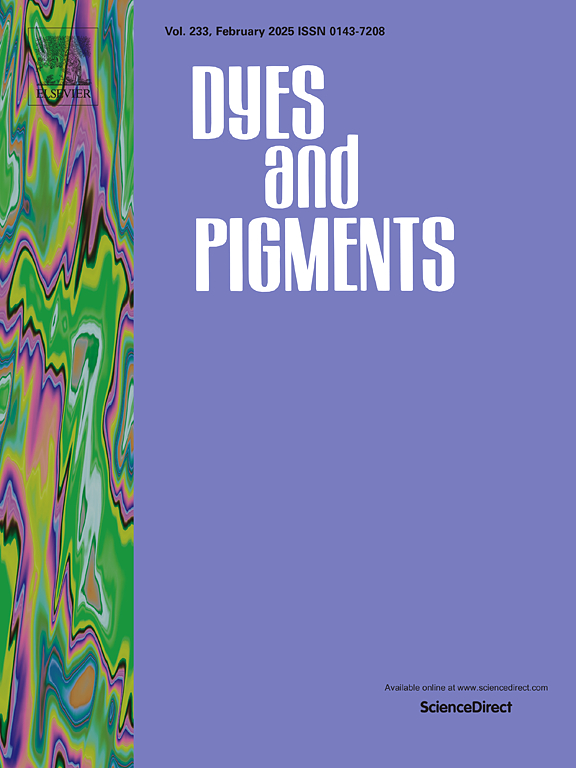Chemically Anchored Black Phosphorus/Chromophore Composite Luminescent Materials towards Solid-State Photoluminescence and Electroluminescence
IF 4.2
3区 工程技术
Q2 CHEMISTRY, APPLIED
引用次数: 0
Abstract
As a promising two-dimensional (2D) material, black phosphorus (BP) has gained great attention because of its intrinsic physicochemical characteristics. However, BP is easy to be oxidized and form various surface defects, which decreases the charge transport and makes luminescence difficult. Herein, we report a facile strategy to synthesize chemically anchored BP/chromophore composite luminescent materials by integrating 2D BP nanosheets with boron dipyrromethene (BODIPY) dyes through simple sonication reactions. Solids of BP composite materials are brightly fluorescent with 5 orders of magnitude increase of photoluminescence intensity compared with the pure solids of BP and BODIPY. 2D BP nanosheets with large specific surface area and lone pair electrons facilitate chemisorption of BODIPY by forming covalent interactions between P and B/N atoms, which not only passivates the surface of BP and eliminates the oxidation, but also prevents the aggregation caused quenching (ACQ) issue of BODIPY. Furtherly, the organic light-emitting diodes (OLEDs) based on the BP/chromophore composite luminescent materials were first successfully achieved, the electroluminescence spectra of which cover the full spectrum of red, green, and blue visible light. This work provides a brand-new approach to further design and development of high mobility and high luminous efficiency composite luminescent materials and devices based on BP.

实现固态光致发光和电致发光的化学锚定黑磷/色团复合发光材料
作为一种前景广阔的二维(2D)材料,黑磷(BP)因其固有的物理化学特性而备受关注。然而,黑磷容易被氧化并形成各种表面缺陷,从而降低了电荷传输能力并使发光变得困难。在此,我们报告了一种通过简单的超声反应将二维 BP 纳米片与硼二吡咯烷(BODIPY)染料整合在一起,从而合成化学锚定 BP/ 色素团复合发光材料的简便策略。BP 复合材料的固体具有明亮的荧光,与 BP 和 BODIPY 的纯固体相比,光致发光强度提高了 5 个数量级。具有大比表面积和孤对电子的二维 BP 纳米片通过 P 原子和 B/N 原子间的共价作用,促进了 BODIPY 的化学吸附,不仅使 BP 表面钝化,消除了氧化,还防止了 BODIPY 的聚集淬灭(ACQ)问题。此外,首次成功实现了基于 BP/色团复合发光材料的有机发光二极管(OLED),其电致发光光谱覆盖了红、绿、蓝可见光的全光谱。这项工作为进一步设计和开发基于 BP 的高迁移率和高发光效率复合发光材料和器件提供了一种全新的方法。
本文章由计算机程序翻译,如有差异,请以英文原文为准。
求助全文
约1分钟内获得全文
求助全文
来源期刊

Dyes and Pigments
工程技术-材料科学:纺织
CiteScore
8.20
自引率
13.30%
发文量
933
审稿时长
33 days
期刊介绍:
Dyes and Pigments covers the scientific and technical aspects of the chemistry and physics of dyes, pigments and their intermediates. Emphasis is placed on the properties of the colouring matters themselves rather than on their applications or the system in which they may be applied.
Thus the journal accepts research and review papers on the synthesis of dyes, pigments and intermediates, their physical or chemical properties, e.g. spectroscopic, surface, solution or solid state characteristics, the physical aspects of their preparation, e.g. precipitation, nucleation and growth, crystal formation, liquid crystalline characteristics, their photochemical, ecological or biological properties and the relationship between colour and chemical constitution. However, papers are considered which deal with the more fundamental aspects of colourant application and of the interactions of colourants with substrates or media.
The journal will interest a wide variety of workers in a range of disciplines whose work involves dyes, pigments and their intermediates, and provides a platform for investigators with common interests but diverse fields of activity such as cosmetics, reprographics, dye and pigment synthesis, medical research, polymers, etc.
 求助内容:
求助内容: 应助结果提醒方式:
应助结果提醒方式:


